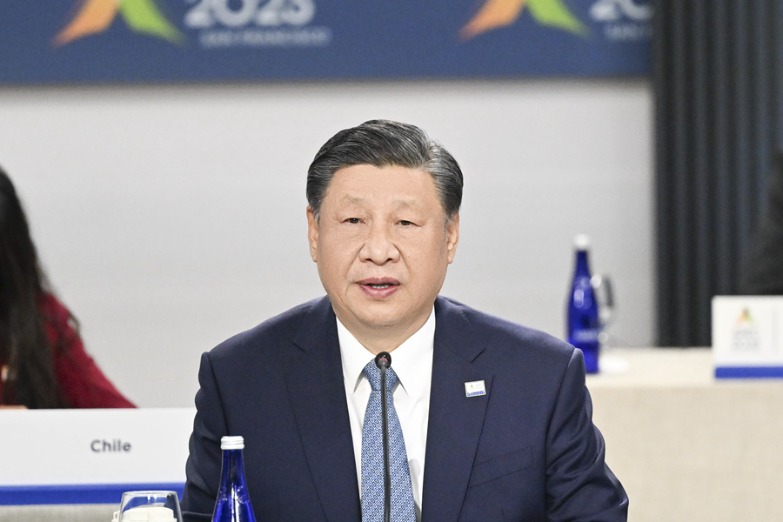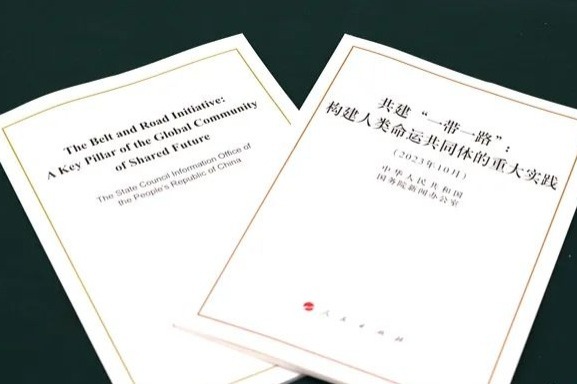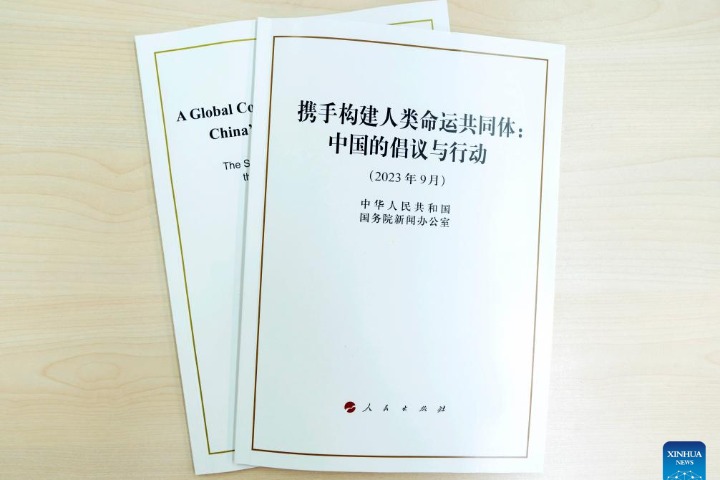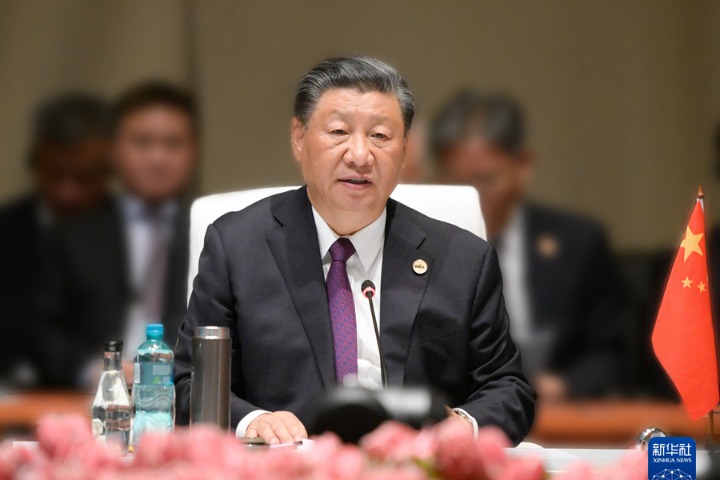西藏和平解放与繁荣发展(双语全文)
新华网 2021-05-21 16:00

国务院新闻办公室5月21日发表《西藏和平解放与繁荣发展》白皮书。

全文如下:
西藏和平解放与繁荣发展
Tibet Since 1951: Liberation, Development and Prosperity
中华人民共和国
国务院新闻办公室
二〇二一年五月·北京
The State Council Information Office of
the People's Republic of China
May 2021
前言
Foreword
一、和平解放前的西藏
I. Tibet Before the Peaceful Liberation
二、实现和平解放
II. Peaceful Liberation
三、社会制度的历史跨越
III. Historic Changes in Society
四、各项事业加快发展
IV. Rapid Development of Various Undertakings
五、脱贫攻坚全面胜利
V. A Complete Victory over Poverty
六、优秀传统文化得到保护和发展
VI. Protection and Development of Traditional Culture
七、民族宗教工作成效显著
VII. Remarkable Results in Ethnic and Religious Work
八、生态安全屏障日益坚实
VIII. Solid Environmental Safety Barriers
九、坚定维护国家统一和社会稳定
IX. Resolutely Safeguarding National Unity and Social Stability
十、新时代新征程
X. Embarking on a New Journey in the New Era
结束语
Conclusion
前言
Foreword
1951年5月23日,《中央人民政府和西藏地方政府关于和平解放西藏办法的协议》(简称《十七条协议》)的签订,宣告西藏和平解放。从此,西藏人民永远摆脱了帝国主义的侵略和羁绊,与全国各族人民一道在祖国大家庭里走上了团结、进步、发展的光明大道。
On May 23, 1951, the Agreement of the Central People's Government and the Local Government of Tibet on Measures for the Peaceful Liberation of Tibet (the 17-Article Agreement) was signed. The people of Tibet broke free from the fetters of invading imperialism for good, embarking on a bright road of unity, progress and development with all the other ethnic groups in China.
以和平解放为起点,西藏各族人民在中国共产党的坚强领导下团结奋进,贯彻执行《十七条协议》,有力维护了国家主权、祖国统一和领土完整;进行民主改革,彻底废除了政教合一的封建农奴制,百万农奴翻身解放、当家作主,各族人民的根本利益得到保障;建立社会主义制度,实行民族区域自治,西藏社会制度实现了历史性跨越;扎实推进改革开放和现代化建设,极大解放和发展了社会生产力,极大改善了西藏各族人民生产生活条件。进入新时代,在以习近平同志为核心的党中央坚强领导下,在全国人民大力支持下,西藏脱贫攻坚全面胜利,社会大局更加稳定、经济文化更加繁荣、生态环境更加良好、人民生活更加幸福,一个崭新的社会主义新西藏呈现在世人面前。
Following the peaceful liberation, all the ethnic peoples of Tibet, united under the strong leadership of the Communist Party of China (CPC), have worked together in implementing the 17-Article Agreement, and stood firm in safeguarding national sovereignty, unity and territorial integrity. Together, they have:
• carried out democratic reform to abolish Tibet's feudal theocratic serfdom, liberating millions of serfs and ensuring the fundamental interests of all ethnic groups in Tibet;
• established the socialist system and implemented regional ethnic autonomy in Tibet, bringing historic changes to Tibetan society; and
• pressed ahead with reform, opening up, and modernization, significantly unleashing the productive potential and improving the lives and working conditions of the people in Tibet.
In the new era, under the strong leadership of the CPC Central Committee with Xi Jinping at the core and with the vigorous support of the whole country, Tibet has eradicated extreme poverty. Enjoying a stable social environment, economic and cultural prosperity, and a sound eco-environment, the people now lead better lives and live in contentment. A brand new socialist Tibet has taken shape.
值此西藏和平解放70周年之际,回顾历史进程、展示伟大成就,全面立体真实展现社会主义新西藏,有助于以事实驳斥境外一些势力散布的种种谎言,有助于国际社会正确认识西藏翻天覆地的历史巨变。
On the occasion of the 70th anniversary of Tibet's peaceful liberation, we are publishing this white paper to review Tibet's history and achievements, and present a true and panoramic picture of the new socialist Tibet. This will help to counter the propaganda spread by a number of Western countries and their allies and provide the international community with a balanced account of the enormous transformation that has taken place in Tibet.
一、和平解放前的西藏
I. Tibet Before the Peaceful Liberation
西藏自古就是中国神圣领土不可分割的一部分,是中国藏族主要聚居区之一。近代以来,以英国为首的帝国主义势力一手制造了所谓的“西藏独立”问题,严重破坏了中国的主权和领土完整。
Tibet has been an integral part of Chinese territory since ancient times, and one of the main Tibetan-inhabited areas in China. In the aftermath of the Opium Wars in the middle of the 19th century, the UK-led imperialist powers began to cultivate the idea of “Tibet independence”, intentionally undermining China's sovereignty and territorial integrity.
——西藏自古是中国不可分割的一部分
–Tibet has been an inseparable part of China since ancient times.
中国是一个历史悠久的统一的多民族国家,中华民族是一个命运共同体。西藏是各民族共同开发的,西藏历史是各民族共同书写的,藏族和其他各民族在政治经济文化上的交流贯穿了西藏历史发展始终,藏族就是在各民族交往交流交融中形成发展起来的。大量考古和学术研究表明,早在远古时期,居住在西藏高原的藏族先民就与汉族和其他兄弟民族有着血缘、语言和文化上的密切联系。公元7世纪在西藏建立的吐蕃地方政权,为中国西南边疆开发作出了重要贡献。
China is a unified multiethnic country with a long history. The Chinese nation is a community of shared future. Tibet has developed through the combined efforts of all the ethnic groups in China, and these are the peoples who have created its history. The political, economic and cultural exchanges between Tibetans and other ethnic groups throughout history have had an important bearing on the development of the Tibetan people as an ethnic group. Abundant archeological and academic research shows that in times of remote antiquity, the ancestral people inhabiting the Tibetan Plateau had close ties with the Han and other ethnic groups in terms of blood, language, and culture. The Tubo Kingdom established in Tibet in the 7th century contributed significantly to the exploration of China's southwestern borders.
元朝(1271-1368年)中央政府实现了对西藏地方的有效管辖和治理。元朝设立总制院(后称宣政院),直接管理西藏地方事务,在西藏清查户口、设置驿站、征收赋税、驻扎军队、任命官员,并将元朝刑法、历法颁行西藏。明朝(1368-1644年)中央政府在西藏实施多封众建,给西藏各地政教首领封以“法王”“王”“灌顶国师”等名号,设置乌思藏、朵甘两个“卫指挥使司”和“俄力思军民元帅府”,分别管理卫藏、昌都等地和阿里地区的军政事务。清朝(1644-1911年)中央政府对西藏地方的管理十分完善,先后册封藏传佛教格鲁派首领五世达赖和五世班禅,正式确立达赖喇嘛与班禅额尔德尼的封号和政治、宗教地位,历世达赖、班禅均须中央政府册封遂成定制。设驻藏大臣,代表中央先后监督、共管西藏军政事务,总计派遣驻藏大臣百余人。1751年,乾隆皇帝授命七世达赖喇嘛与驻藏大臣共同管理西藏地方政教事务。1793年,清朝政府在驱除廓尔喀入侵势力之后整顿西藏地方秩序,颁布《钦定藏内善后章程二十九条》,完善中央政府治理西藏地方的多项制度,明确规定达赖等大活佛转世须经金瓶掣签认定,并报中央政府批准。此后清代五位达赖喇嘛中,三位经金瓶掣签认定,其余两位经中央政府特批免于金瓶掣签。
In the Yuan Dynasty (1271-1368), the central government exercised jurisdiction and governance over Tibet. It established the Supreme Control Commission of Buddhism (later renamed the Commission for Buddhist and Tibetan Affairs) to directly manage local affairs in the region, conducting censuses, setting up courier stations, collecting taxes, stationing troops and appointing officials. It also issued and enacted the Yuan criminal law and calendar in Tibet.
The central government of the Ming Dynasty (1368-1644) implemented a policy of multiple enfeoffment, conferring honorific titles such as “Prince”, “Prince of Dharma”, and “National Master in Tantrism” on political and religious leaders in various parts of Tibet. It established the U-Tsang and Do-kham regional military commissions and the Ngari Commanding Tribal Office to manage military and political affairs in U-Tsang, Qamdo and Ngari respectively.
During the Qing Dynasty (1644-1911), the central government exercised sound governance over Tibet. It granted honorific titles to the leaders of the Gelug school of Tibetan Buddhism – the 5th Dalai Lama and the 5th Panchen Lama – officially establishing the titles of the Dalai Lama and Panchen Erdeni and their political and religious status in Tibet. From then on, it became an established convention that the central government conferred the titles of Dalai Lama and Panchen Erdeni. The Qing government began to station Grand Ministers Resident in Tibet to supervise and jointly manage local military and political affairs on behalf of the central authorities; in total it appointed more than 100 such ministers. In 1751, Qing Emperor Qianlong authorized the 7th Dalai Lama to jointly manage local political and religious affairs with the Grand Minister Resident in Tibet. In 1793, after dispelling Gurkha invaders, the Qing government restored order in Tibet and promulgated the Imperially Approved Ordinance for Better Governance of Tibet (the 29-Article Ordinance), improving several of the systems by which the central government administered Tibet. The ordinance stipulated that the reincarnation of the Dalai Lama and other grand Living Buddhas had to follow the procedure of “drawing lots from the golden urn”, and the selected candidate would be subject to approval by the central government of China. Observing the ordinance, three of the five Dalai Lamas in the Qing Dynasty were selected and approved in accordance with this procedure, and the other two were exempted from the procedure with special approval from the central government.
清朝灭亡后,中华民国继续对西藏实施主权管辖。1912年,中华民国第一部宪法《中华民国临时约法》明确规定中央对西藏的主权,宣布“西藏是中华民国领土的一部分”,提出“合汉、满、蒙、回、藏诸族为一人,实行五族共和”。同年7月,民国政府设蒙藏事务局。1929年,南京国民政府设立蒙藏委员会,管理蒙藏事务。1940年,国民政府在拉萨设蒙藏委员会驻藏办事处,作为中央政府在西藏地方的常设机构。民国时期官方和民间出版机构出版的世界地图和中国地图,均将西藏列为中国领土。虽然民国期间军阀混战,内乱频仍,国家孱弱,但中央政府仍坚定地维护了国家在西藏的主权。十四世达赖、十世班禅继续接受了中央政府的册封。国际上没有一个国家和政府承认过“西藏独立”。
After the downfall of the Qing Dynasty, the Republic of China (ROC) continued to exercise sovereignty over Tibet. In 1912, the ROC issued its first constitution – the Provisional Constitution of the Republic of China, which reaffirmed the central government's sovereignty over Tibet. It clearly stipulated that “Tibet is a part of the territory of the ROC”, and stated that “the Han, Manchu, Mongol, Hui and Tibetan peoples are of one nation, and are to run the Republic together.” In July, the government set up the Bureau of Mongolian and Tibetan Affairs. The Nanjing National Government set up the Commission for Mongolian and Tibetan Affairs in 1929 to act in the same capacity. In 1940, the Commission for Mongolian and Tibetan Affairs opened an office in Lhasa as the permanent organ representing the central government in Tibet. Under the ROC, Tibet was clearly identified as Chinese territory in world maps and maps of China issued by government and non-government publishers. The central government of the ROC safeguarded the nation's sovereignty over Tibet in spite of frequent civil wars among warlords and a weak state, and following the tradition by conferring the official titles on the 14th Dalai Lama and the 10th Panchen Lama. No country or government in the world has ever acknowledged the “independence of Tibet”.
——所谓“西藏独立”问题是近代帝国主义侵略中国的产物
– “Tibetan independence” was a product of imperialist aggression against China in modern times.
自18世纪以来,西方一些势力就通过“探险”“考察”等手段觊觎我西藏。19世纪末,帝国主义掀起瓜分中国的狂潮,英国侵略势力趁机染指西藏。鸦片战争后,英国加紧从英属印度侵略西藏,先后于1888年、1903年两次武装入侵,遭到当地军民坚决抵抗。在武装侵略未能达到目的后,又转而在西藏培植亲帝分裂势力,策划、煽动“西藏独立”。1907年,英俄秘密签订《西藏协定》,在中国政府不知情的情况下,第一次在国际文件中将中国对西藏地方的主权篡改为“宗主权”。1913年,英国策划召开西姆拉会议,唆使西藏地方代表首次提出“西藏独立”的无理要求,当即遭到中国政府代表严词拒绝。这便是“西藏独立”一词的首次出笼。1914年7月,中国政府代表拒绝在《西姆拉条约》上签字,并发表声明概不承认任何此类条约或文件,同时将该立场照会英国政府,西姆拉会议遂以失败告终。
Western attempts on Tibet began in the 18th century, pioneered by “adventurers” and “explorers” who made trips to the region. At the end of the 19th century, imperialist powers engaged in a fervent spree of carving up China, and the British aggressors took the opportunity to invade Tibet. British troops invaded Tibet twice in 1888 and 1903 and met with stubborn resistance from the Tibetan army and civilians. Its invasion plans thwarted, Britain began to cultivate pro-imperialist separatists in Tibet, devising activities to separate Tibet from China and championing “Tibet independence”. In 1907, Britain and Russia signed the Convention Between Great Britain and Russia on Tibet, without the Chinese government's knowledge, changing China's sovereignty over Tibet into “suzerainty” in an international document for the first time. In 1913, the British government engineered the Simla Conference to instigate the Tibetan representative to raise the issue of “Tibetan independence”, which was immediately rejected by the representative of the Chinese government. This was the first time the concept had been made public. In July 1914, the representative of the Chinese government refused to sign the Simla Convention, and made a statement saying that the government of China refused to recognize any such agreement or document. The Chinese government also sent a note to the British government, reiterating its position. Thereupon, the conference collapsed.
1942年,西藏地方政府在英国代表支持下突然宣布成立“外交局”,公开进行“西藏独立”活动,因遭到全国人民和国民政府的反对而不得不改变原议。1947年,英国幕后策划邀请西藏派代表参加“泛亚洲会议”,在会场上悬挂的亚洲地图和万国旗中把西藏作为一个独立国家来对待,经中国代表团严正交涉,会议组织者不得不改正这种错误做法。中华人民共和国成立前后,帝国主义加快了与西藏亲帝分裂势力勾结的步伐,1949年7月8日,西藏地方政府以“防止共产党混迹西藏”为借口,下令将国民政府驻藏办事处人员及相关人员驱赶出西藏,制造了拉萨“七·八”事件。1949年11月,西藏地方政府决定派所谓的“亲善使团”赴美国、英国、印度、尼泊尔等国,寻求对“西藏独立”的政治支持和军事援助,加紧分裂国家的活动。1949年,美国人劳尔·汤姆斯(Lowell Thomas)以哥伦比亚广播公司“无线电评论员”名义在西藏图谋“华盛顿给西藏以可能的援助”,并在美国报刊上宣称“美国已准备承认西藏为独立自由”的国家。1950年上半年,一批美国枪支弹药经由加尔各答进入西藏,用以对抗中国人民解放军进藏。
In 1942, the local government of Tibet, with the support of the British representative, suddenly announced the establishment of a “foreign affairs bureau” and began to openly engage in “independence” activities. With opposition from the Chinese people and the national government, the local government of Tibet had no choice but to withdraw its decision. In 1947, Britain conspired behind the scenes to invite Tibetan representatives to attend the Asian Relations Conference, and even identified Tibet as an independent country on the map of Asia hung in the conference hall and in the array of national flags. The organizers were forced to rectify this after the Chinese delegation made a stern protest.
Around the time of the founding of the People's Republic of China (PRC) in 1949, imperialists accelerated their collusion with pro-imperialist separatists in Tibet. On July 8, 1949, the local government of Tibet issued an order to expel officials of the Tibet Office of the Commission for Mongolian and Tibetan Affairs on the pretext of “prohibiting Communists from staying in Tibet”. In November 1949, the local government of Tibet decided to dispatch a “goodwill mission” to the United States, Britain, India, Nepal and a number of other countries, seeking political and military support for “independence” and making it obvious that it was intensifying separatist activities. In 1949, the American Lowell Thomas crossed Tibet in the guise of a “radio commentator” of the Columbia Broadcasting System to explore the “possibility of aid that Washington could give Tibet”. He wrote in a US newspaper: “The United States is ready to recognize Tibet as an independent and free country.” In the first half of 1950, American weaponry was shipped into Tibet through Calcutta in order to help resist the People's Liberation Army's entry into Tibet.
历史事实清楚地证明,所谓“西藏独立”问题完全是帝国主义侵略中国的产物,驱逐帝国主义势力出西藏是中国人民维护祖国统一的必然要求。
Historical facts clearly demonstrate that “Tibetan independence” was no more than a product of imperialist aggression against China. Driving imperialist forces out of Tibet was the precondition for the Chinese people to safeguard national unification.
——解放西藏是各族人民的热切期盼
– Liberating Tibet was the shared aspiration of all ethnic groups in Tibet.
1949年9月2日,中国共产党授权新华社发表题为《决不容许外国侵略者吞并中国的领土——西藏》的社论,指出“西藏是中国的领土,绝不容许任何外国侵略;西藏人民是中国人民的一个不可分离的组成部分,绝不容许任何外国分割。这是中国人民、中国共产党和中国人民解放军的坚定不移的方针”。社论发表后,西藏各界纷纷响应和拥护,盼望解放军早日进藏。就在新中国成立当天,十世班禅致电中央政府:“速发义师,解放西藏,驱逐帝国主义势力。”12月2日,原西藏摄政五世热振活佛的近侍益西楚臣到西宁,向人民解放军控诉帝国主义破坏西藏内部团结的罪行,请求迅速解放西藏。当时在西藏颇有声望的藏族学者喜饶嘉措也在西安发表谈话,谴责帝国主义策划拉萨当局进行所谓“独立”的阴谋。1950年初,藏族农牧民、青年、妇女和民主人士代表百余人在刚刚解放的兰州集会,要求解放西藏。
On September 2, 1949, Xinhua News Agency, with authorization from the CPC, published an editorial under the headline, “Foreign Aggressors Are Resolutely Not Allowed to Annex China's Territory – Tibet”. The editorial pointed out, “Tibet is part of the Chinese territory; no foreign aggression is allowed. The Tibetan people are an inseparable part of the Chinese nation, and any attempt to divide them from China will be doomed. This is a consistent policy of the Chinese people, the CPC and the People's Liberation Army (PLA).”
All sectors of society of Tibet quickly responded and expressed support for the editorial and the hope that the PLA would enter Tibet as soon as possible. On October 1, 1949, the day the PRC was founded, the 10th Panchen Lama sent a telegram to the central government: “Please send troops to liberate Tibet and expel the imperialists as soon as possible.”
On December 2, Yeshe Tsultrim, an aide of the 5th Regent Reting Rinpoche, arrived in Xining, Qinghai Province, to lodge complaints with the PLA about the imperialists destroying the internal unity of Tibet, and urged the PLA to liberate Tibet as soon as possible.
Sherab Gyatso, a prominent Tibetan scholar, delivered a talk in Xi'an, denouncing an imperialist conspiracy through which Lhasa authorities would seek “independence”. In early 1950, over 100 Tibetan people, including farmers and herdsmen, young people, women and democratic representatives, assembled in Lanzhou in Gansu Province, which had been liberated not long before, and urged the PLA to liberate Tibet.
毛泽东主席和朱德总司令在复电十世班禅时指出:“西藏人民是爱祖国而反对外国侵略的,他们不满意国民党反动政府的政策,而愿意成为统一的富强的各民族平等合作的新中国大家庭的一分子。中央人民政府和中国人民解放军必能满足西藏人民的这个愿望。”在中央人民政府的英明决策和全国各族人民的共同企盼下,解放西藏的伟大事业正式开启。
In their reply to the 10th Panchen Lama, Mao Zedong and Zhu De stated, “The Tibetan people love the motherland and stand against foreign aggression. They are discontent with the policies of the reactionary Kuomintang government, and want to be part of the big family of a unified New China, where all ethnic groups are equal and work together for prosperity. The Central People's Government and the Chinese PLA will certainly comply with this wish of the Tibetan people.” With determined support from the Central People's Government, Tibet saw the hope of a peaceful liberation anticipated by the whole of China.
二、实现和平解放
II. Peaceful Liberation
为了应对国际形势的复杂变化和西藏地方的严峻局势,满足西藏人民要求早日解放的愿望,1949年12月,毛泽东主席在前往苏联访问、途经满洲里时,写信给中共中央,作出了“进军西藏宜早不宜迟”的战略决策。
To address the complex and changing international landscape and the difficult situation in Tibet, and to satisfy the Tibetan people's wish for liberation as soon as possible, Mao Zedong wrote a letter to the CPC Central Committee while in Manzhouli on his way to the Soviet Union for a visit in December 1949. In the letter, Mao made the strategic decision that “it is better for the PLA to enter Tibet sooner rather than later.”
——昌都战役的胜利,为西藏和平解放创造条件
– The victory in the Qamdo Battle created the conditions for the peaceful liberation of Tibet.
根据进藏交通状况和西藏的民族、宗教特点,毛泽东主席提出“政治解决优先”和解放西藏“不应操之过急”的基本方针,中央人民政府随后组织开展了大量的政治争取工作,先后多次派代表团或代表赴西藏进行劝和,争取能像解放北平、绥远、新疆等地一样实现西藏和平解放。1950年2月,西北局派出藏族干部张竞成携带青海省人民政府副主席廖汉生致十四世达赖和摄政达扎·阿旺松饶的书信等赴藏联络劝和。3月,在中共中央批准和西南局组织下,与西藏政教界有着良好关系的汉族高僧志清法师由成都启程赴藏。7月,以塔尔寺当才活佛为团长的青海寺院赴藏劝和团从西宁出发。青海省人民政府副主席、著名藏族学者喜饶嘉措向十四世达赖和藏族同胞发表广播讲话,呼吁西藏地方政府“迅速派遣全权代表赴京进行和平协商”。同月,西康省甘孜白利寺五世格达活佛一行赴藏。
Considering the difficulties of transport and the ethnic and religious characteristics of Tibet, Mao Zedong proposed two basic principles – to prioritize a political settlement, and to avoid undue haste in liberating Tibet. The Central People's Government organized and carried out a lot of work in political persuasion, sending delegates or delegations to Tibet for mediation on several occasions in order to achieve peaceful liberation, a strategy with proven success for Beiping (Beijing), Suiyuan and Xinjiang. In February 1950, the Northwest Bureau of the CPC Central Committee sent a Tibetan official named Zhang Jingcheng to Tibet with a letter from Liao Hansheng, then vice chairman of the Qinghai Provincial People's Government, directed to the 14th Dalai Lama and Regent Taktra Ngawang Sungrab. In March, an eminent Han monk, Master Zhiqing, who had good contacts in the political and religious circles of Tibet, set out for Tibet from Chengdu, with the approval of the CPC Central Committee and the support of the Southwest Bureau. In July, a delegation composed of members from Qinghai temples and monasteries, led by Taktser Rinpoche of Kumbum Monastery, set out from Xining. Sherab Gyatso, vice chairman of the Qinghai Provincial People's Government and a leading Tibetan scholar, delivered a radio talk, calling on the local government of Tibet to “quickly dispatch plenipotentiary representatives to Beijing for peace talks”. Also in this month, a delegation including the 5th Gedar Tulku of Beri Monastery in Garze, Xikang, went to Tibet.
然而,这一系列劝和促谈活动,受到帝国主义侵略势力和西藏亲帝分裂分子的重重阻挠。与此同时,西藏上层分裂分子与历史发展潮流背道而驰,不顾地方经济凋敝而扩大军备、调遣藏军,妄图以武力抵抗人民解放军,还勾结帝国主义势力,建立电台、散布谣言,人为制造民族隔阂,派出所谓“亲善使团”寻求一些国家对“西藏独立”的支持。
However, these mediation activities suffered obstruction from Western imperialists and pro-imperialist separatists in Tibet. In the meantime, in spite of local economic decline, the separatists from the upper classes of Tibet expanded the Tibetan army and dispatched troops in an attempt to halt the PLA's advance. They also colluded with their imperialist supporters to set up radio stations, spread rumors to deepen the rifts among the Han and local people, and dispatched a “goodwill mission” to seek support from other countries.
在这种情况下,中共中央和毛泽东主席意识到解放西藏已经迫在眉睫。西南局和西北局在中央人民政府的统一部署下,迅速做好进军西藏的准备。进藏部队按照“政治重于军事,补给重于战斗”原则,根据中央“多路向心进兵”部署,以十八军为主力的人民解放军分四路向西藏进军,并于1950年10月取得昌都战役的胜利。昌都解放后,召开了昌都地区第一次人民代表会议,选举产生了昌都地区人民解放委员会,成立了昌都地区僧俗人民争取和平解放西藏工作委员会。昌都战役的胜利为促进西藏和平解放创造了条件。中央人民政府和毛泽东主席始终没有放弃和平解放西藏的努力,在昌都战役进行中仍催促西藏地方政府尽快派人来京。
In the circumstances, Mao Zedong and the CPC Central Committee realized that the liberation of Tibet was a matter of extreme urgency. Under the unified deployment of the Central People's Government, the southwest and northwest bureaux of the CPC Central Committee issued a prompt order for troops to stand by.
The PLA troops followed the principles that military operations should only be carried out when political persuasion failed and the troops had sufficient supplies to fight a battle. Guided by the central authorities' strategy of outflanking the enemy from various directions, the PLA, with the 18th army as the major force, advanced into Tibet from four directions and won the Battle of Qamdo in October, 1950.
After the victory, the First People's Congress of Qamdo was held. The Qamdo People's Liberation Committee was elected and a working committee for the peaceful liberation of Tibet was founded, composed of both ecclesiastical and secular representatives. The battle created the conditions for the peaceful liberation of Tibet. The Central People's Government and Chairman Mao Zedong had never given up their efforts to this end. Even during the battle, Mao Zedong urged that a local Tibetan delegation should come to Beijing as soon as possible.
——签订《十七条协议》,西藏实现和平解放
– Signing the 17-Article Agreement marked the liberation of Tibet.
昌都战役的胜利使西藏地方政府的爱国进步力量进一步增强,西藏地方政局朝着有利于和平解放的趋势发展。1951年2月,西藏地方政府“官员会议”决定正式派出代表到北京同中央人民政府和谈。十四世达赖在致中央人民政府的信中也表达了和平谈判的愿望。4月29日,中央人民政府和西藏地方政府关于和平解放西藏的谈判正式开始。双方经过认真协商和充分讨论,最终就西藏和平解放一系列问题达成协议,于5月23日在北京签订了《中央人民政府和西藏地方政府关于和平解放西藏办法的协议》(简称《十七条协议》),宣告西藏和平解放。
The victory at Qamdo gave the upper hand to the patriotic and progressive forces within the local government of Tibet, and the political situation moved in the direction of peaceful liberation. In February 1951, an “officials' meeting” of the local government of Tibet decided to send a formal delegation to Beijing to conduct peace negotiations with the Central People's Government. The 14th Dalai Lama expressed his wish for peace talks in a letter to the Central People's Government. On April 29, the Central People's Government and the local government of Tibet began official negotiations for the peaceful liberation. After serious consultations and thorough discussions, they signed the 17-Article Agreement in Beijing on May 23.
《十七条协议》明确:“西藏人民团结起来,驱逐帝国主义侵略势力出西藏,西藏人民回到中华人民共和国祖国大家庭中来”“人民解放军进入西藏,巩固国防”“中央人民政府统一处理西藏地区的一切涉外事宜”“西藏地方政府积极协助人民解放军进入西藏,巩固国防”“在中央人民政府统一领导之下,西藏人民有实行民族区域自治的权利”“尊重西藏人民的宗教信仰和风俗习惯”。《十七条协议》明确,对于达赖喇嘛和班禅额尔德尼的固有地位及职权,中央亦不予变更;原西藏地方政府中的各级官员,可以照常供职。《十七条协议》的签订,标志着中国大陆实现了完全解放,新中国在西藏的主权地位得到完整体现,团结了各方力量,维护了西藏社会大局稳定,保障了中国共产党民族、宗教、经济、文化政策在西藏的实行,为西藏社会发展改革打下了坚实的政治基础。
The 17-Article Agreement stipulates:
• The people of Tibet shall unite and drive out aggressive imperialist forces; they will return to the family of the People's Republic of China.
• The PLA troops shall enter Tibet to consolidate national defense.
• All foreign-related affairs of Tibet shall be dealt with by the Central People's Government on a centralized basis.
• The local government of Tibet shall actively assist the PLA to enter Tibet and consolidate the national defense.
• The Tibetan people shall have the right of regional ethnic autonomy under the unified leadership of the Central People's Government.
• The religious beliefs and customs of the Tibetan people shall be respected.
The agreement also clarified that the central authorities would not alter the established status, functions and powers of the Dalai Lama and Panchen Erdeni, and that former officials of all ranks in the local government of Tibet could continue to hold office. The signing of the 17-Article Agreement symbolized the final liberation of all the Chinese mainland, embodied the full sovereignty of the People's Republic in Tibet, united all forces to safeguard overall social stability, ensured the enforcement of the CPC's ethnic, religious, economic and cultural policies, and laid a solid political foundation for social development and reform in Tibet.
《十七条协议》的签订,得到全国各族各界的拥护。1951年5月28日,《人民日报》用汉藏两种文字对外公布协议全文,同时发表题为《拥护关于和平解放西藏办法的协议》的社论,指出这是西藏人民从黑暗和痛苦走向光明和幸福的第一步。北京、西安、重庆、成都,以及新疆、内蒙古等地各族群众集会游行,热烈庆祝《十七条协议》的签订。
The 17-Article Agreement gained the support of all ethnic groups and people from all walks of life across the country. On May 28, 1951, the People's Daily published in full the agreement in both Chinese and Tibetan accompanied by an editorial entitled “Supporting the Agreement on Measures for the Peaceful Liberation of Tibet”. The article made the point that this was the first step for the Tibetan people out of a dark and miserable past and toward a bright and happy future. Assemblies and processions were held in Beijing, Xi'an, Chongqing, Chengdu, Xinjiang and Inner Mongolia to celebrate the signing of the agreement.
同日,十世班禅及班禅堪布会议厅全体人员发表声明拥护协议,表示“我们今后坚决拥护毛主席的领导,拥护中央人民政府和中国共产党的领导”。10月24日,十四世达赖以西藏地方政府和他个人名义,向中央人民政府致电拥护协议,表示“中央人民政府毛主席:今年西藏地方政府特派全权代表噶伦阿沛等五人于1951年4月底抵达北京,与中央人民政府指定的全权代表进行和谈。双方代表在友好基础上已于1951年5月23日签订了关于和平解放西藏办法的协议。西藏地方政府及藏族僧俗人民一致拥护,并在毛主席及中央人民政府领导下积极协助人民解放军进藏部队巩固国防,驱逐帝国主义势力出西藏,保护祖国领土主权的统一”。
On the same day, the 10th Panchen Lama and the Panchen Kampus Assembly made a statement in support of the agreement, declaring, “We will be the staunch supporters of Chairman Mao's leadership, and of the leadership of the Central People's Government and the CPC.” On October 24, the 14th Dalai Lama, on behalf of the local government of Tibet and himself, sent a telegram to the Central People's Government to express his support for the agreement, which read, “Chairman Mao of the Central People's Government: This year the local government of Tibet sent five delegates with full authority, headed by Kalon Ngapoi, to Beijing in late April 1951 to conduct peace talks with delegates with full authority appointed by the Central People's Government. On the basis of friendship, the delegates of the two sides signed on May 23, 1951 the Agreement on Measures for the Peaceful Liberation of Tibet. The local government of Tibet as well as the ecclesiastical and secular people unanimously support this agreement, and, under the leadership of Chairman Mao and the Central People's Government, will actively assist the PLA troops entering Tibet to consolidate national defense, ousting imperialist influences from Tibet and safeguarding the unification of the territory and the sovereignty of the motherland.”
——落实《十七条协议》,维护国家主权和促进社会发展
– Implementing the 17-Article Agreement to safeguard national sovereignty and promote social development
按照《十七条协议》,从1951年9月到1952年6月,人民解放军各路进藏部队先后到达拉萨,进驻(抵)太昭、江孜、日喀则、山南隆子宗、亚东、察隅、改则等地,完成进军西藏任务,结束了西藏4000多公里边境线上长期有边无防的历史。
In line with the 17-Article Agreement and between September 1951 and June 1952, the PLA troops in Tibet reached Lhasa and were dispatched to Gyamda, Gyangze, Xigaze, Lhunze Dzong, Yadong, Zayu and Gerze. For the first time in history Tibet's 4,000-km border was fully and properly defended.
1952年9月6日,中央人民政府驻西藏代表外事帮办办公室成立,在中央人民政府外交部领导下,具体处理西藏地方一切涉外事宜。1954年4月29日,中印双方在京签订《关于中国西藏地方和印度之间的通商和交通协定》,同时互换照会,取消印度继承的英国侵略西藏遗留下来的特权。1956年9月20日,中国和尼泊尔签订《中华人民共和国和尼泊尔王国保持友好关系以及关于中国西藏地方和尼泊尔之间的通商和交通的协定》,取消了尼泊尔在西藏的特权。至此,完全实现了由中央政府统一处理西藏地区的一切涉外事宜。
On September 6, 1952, the foreign affairs office of the Central People's Government representative stationed in Tibet was set up, taking responsibility for all the foreign-related affairs of Tibet under the leadership of the Ministry of Foreign Affairs of the Central People's Government. On April 29, 1954, in Beijing, China and India signed the Agreement on Trade and Intercourse Between the Tibet Region of China and India and exchanged diplomatic notes, abolishing the privileges India had inherited from the British invaders. On September 20, 1956, China and Nepal signed the Agreement on Maintaining Friendly Relations Between the People's Republic of China and the Kingdom of Nepal and on Trade and Intercourse Between the Tibet Region of China and Nepal, which cancelled Nepal's privileges in Tibet. Henceforth, all the foreign-related affairs of Tibet would be dealt with by the Central People's Government on a centralized basis.
中央人民政府作出“进军西藏,不吃地方”及“精打细算,生产自给”等指示,提出“保障军需,兼顾民用”“统一采购,紧缩开支”等一系列财经政策。人民解放军进驻拉萨后,先后建立“七一农场”“八一农场”开垦生产,依靠自身站稳脚跟。同时从羊毛出口贸易着手,解决军需民用问题。
The Central People's Government issued a series of specific instructions and policies. Troops would be stationed in Tibet but would not depend on the local people for their grain supplies. They would operate according to a strict budget and produce what they needed. Food supplies would be guaranteed for the army itself while taking into consideration civilian needs. There would be unified procurement and economy would be practiced. Soon after the PLA troops entered Lhasa, they set up the Qiyi and Bayi Farms, reclaiming land to provide for themselves. They also used the revenues from export of wool to support the PLA and the local people.
在中央人民政府推动下,1952年4月,十世班禅自青海返回西藏,与十四世达赖友好会晤。1953年,十四世达赖和十世班禅当选为中国佛教协会名誉会长,功德林活佛被选为副会长。1954年9月,十四世达赖、十世班禅联袂赴京参加新中国第一届全国人民代表大会第一次会议,十四世达赖当选全国人大常委会副委员长。12月25日,十世班禅在全国政协二届一次会议上,被选为全国政协副主席。1952年至1957年,中央政府组织了13批1000多人次到其他省市参观、访问,成员包括西藏各地僧俗官员、僧人、青年和妇女,增进了西藏与其他省市的联系和各民族团结。
Encouraged by the Central People's Government, the 10th Panchen Lama returned to Lhasa from Qinghai Province to have an amicable meeting with the 14th Dalai Lama in April 1952. In 1953, the Dalai and Panchen lamas were elected as honorary presidents of the Buddhist Association of China, with Living Buddha Kundeling as vice president. In September 1954, the Dalai and Panchen lamas went together to Beijing to attend the First Session of the First National People's Congress (NPC) of the People's Republic of China, with the former elected vice-chairman of the NPC Standing Committee. On December 25, the 10th Panchen Lama was elected vice chairman of the National Committee of the Chinese People's Political Consultative Conference (CPPCC) at its First Plenary Session of the Second National Committee. From 1952 to 1957, a total of over 1,000 people in 13 groups, including ecclesiastical and secular officials, monks, and ordinary people including women and youngsters, made organized trips to other parts of the country, which strengthened connections between Tibet and the rest of the country and promoted national unity.
《十七条协议》签订后,在中央人民政府领导下,西藏各项事业发展明显加快。现代教育体系逐步建立。1951年3月,创办西藏第一所新型学校——昌都小学。1952年8月,创办拉萨小学,随后,日喀则、山南等地先后创办28所公办小学。1956年9月,西藏历史上第一所现代正规初级中学——拉萨中学正式成立。1958年9月,西藏公学在陕西咸阳正式开学,当年共招收学生3460人,其中绝大部分是农奴子女。交通运输条件明显改善。1954年,川藏、青藏公路同时建成通车到达拉萨。1956年,西藏第一座机场——当雄机场全部竣工,北京至拉萨正式通航。现代农牧工商业逐渐起步。大力发展种植业,改进农业灌溉系统。先后建成不同规模的小型工厂,各主要城镇办起了医院、银行、商店、邮局等服务机构。文化事业明显进步。1953年10月1日,拉萨有线广播站正式成立,有线广播开播,并用藏语直播。1956年4月22日,《西藏日报》藏、汉两种文版创刊。群众文化活动丰富多彩,多地组建各种文工团和联谊会。1954年,新组建的西藏歌舞团到北京、上海、广州等地演出,受到当地广大干部群众的热烈欢迎。
After the signing of the 17-Article Agreement, rapid progress was made in all social undertakings of Tibet under the leadership of the Central People's Government.
A modern education system was gradually put in place. In March 1951, Qamdo Primary School was set up – the first modern school in Tibet. In August 1952, Lhasa Primary School was founded. Soon afterwards, 28 public primary schools were set up in locations such as Xigaze and Shannan. In September 1956, Lhasa Middle School was established – the first modern and standard middle school in the history of Tibet. In September 1958, Xizang Minzu University officially opened in Xianyang, Shaanxi Province, enrolling a total of 3,460 students, most of whom were the children of former serfs.
There were significant improvements in transport infrastructure. In 1954, the Qinghai-Tibet Highway and the Sichuan-Tibet Highway, both terminating at Lhasa, were completed and opened to traffic. In 1956, Damxung Airport – Tibet's first airport – was completed, linking Beijing and Lhasa through official air services.
Modern agriculture, animal husbandry, industry and commerce began to emerge. Great efforts were made to improve crop farming and agricultural irrigation. Small factories of various sizes were built. Hospitals, banks, stores and post offices were set up in major cities and towns.
Visible progress was made in cultural undertakings. On October 1, 1953, a radio station was set up in Lhasa, broadcasting live programs in Tibetan. On April 22, 1956, the Tibet Daily started publication in both Tibetan and Chinese. A variety of rich and varied recreational activities were set up, including art troupes and social clubs. In 1954, newly-established performing groups from Tibet went on a performance tour in cities such as Beijing, Shanghai and Guangzhou. They were universally and warmly welcomed by local audiences.

















 英语点津微信
英语点津微信 双语小程序
双语小程序